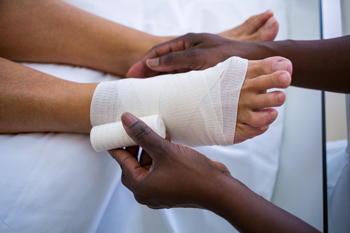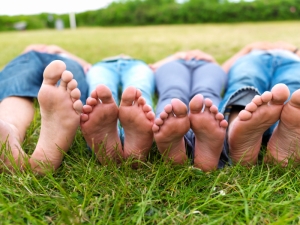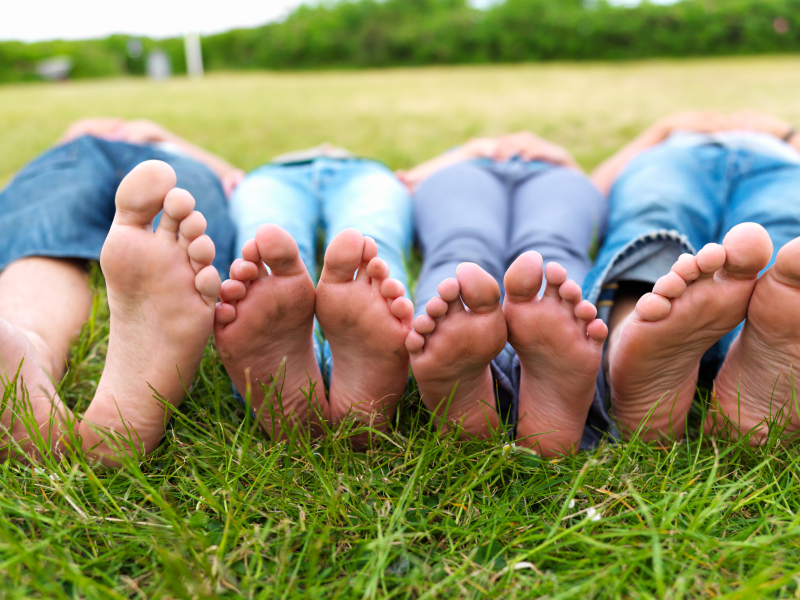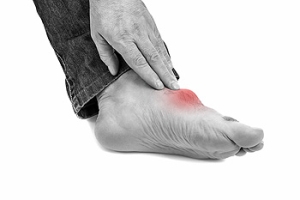
Conditions That May Affect Your Child’s Feet
There are many children that experience foot conditions during their childhood and teenage years. The ankle may become weak from frequently participating in running and jumping activities, and this may result in ankle sprains. This typically causes difficulty in walking, and mild relief may be felt when the affected foot is elevated and wrapped with an elastic bandage. Older teens may develop a condition known as athlete’s foot. This is caused by a fungus that lives in warm environments, and can thrive in moist socks and sneakers. Active children may develop blisters on their feet. This is often caused by excess friction that can come from wearing shoes that do not fit correctly. If you would like additional information about foot conditions your child may have developed, it is advised that you speak to a podiatrist.
Making sure that your children maintain good foot health is very important as they grow. If you have any questions, contact Dr. Michael A. Wood of Foot Health Institute. Our doctor can provide the care you need to keep you pain-free and on your feet.
Keeping Children's Feet Healthy
Having healthy feet during childhood can help prevent medical problems later in life, namely in the back and legs. As children grow, their feet require different types of care. Here are some things to consider...
Although babies do not walk yet, it is still very important to take care of their feet.
Avoid putting tight shoes or socks on his or her feet.
Allow the baby to stretch and kick his or her feet to feel comfortable.
As a toddler, kids are now on the move and begin to develop differently. At this age, toddlers are getting a feel for walking, so don’t be alarmed if your toddler is unsteady or ‘walks funny’.
As your child gets older, it is important to teach them how to take care of their feet.
Show them proper hygiene to prevent infections such as fungus.
Be watchful for any pain or injury.
Have all injuries checked by a doctor as soon as possible.
Comfortable, protective shoes should always be worn, especially at play.
If you have any questions please feel free to contact one of our offices located in Lansing, and Chicago, IL . We offer the newest diagnostic and treatment technologies for all your foot and ankle needs.
What to Do to Keep Your Child’s Feet Healthy
Being a parent involves caring for your child in every way you can. You make sure they are eating the right food, being nice to others, and staying out of any trouble. However, it is also important that you are watchful of their health, more specifically their foot health. Maintaining good foot health in childhood is important in preventing later conditions in life from happening. As children continue to develop, their feet require different techniques of care. Here are some various ways in which you can help your child’s feet stay healthy.
A baby needs a lot of care and attention overall, but the importance of their feet should never be forgotten. Before a baby turns one, their feet change and develop greatly. It is important that during this time, a mother avoids putting tight socks on their child. She should also encourage movement of their feet so the baby can begin to feel more comfortable using them.
As a baby enters the toddler years of his or her life, they are begin to walk around. When your baby begins to take those first steps, it is crucial that they are wearing protective shoes on their feet. As a mother that is observant of your child’s feet, you may notice changes in them. This is completely normal as the feet are becoming susceptible to the activity of walking. It is normal for a toddler to be a bit unsteady or to “walk funny” at first.
When your child grows out of their toddler years, it is important that you begin to show him or her how to care for their feet on their own. Practice with your child proper hygiene in order to prevent foot fungus or infection. Since children are constantly on the move, it is crucial to be cautious of any accidents or injuries that might occur. If an injury occurs, it is advised that you take your child to be examined by a doctor immediately. Since your child is still growing, particular injuries can shift the way in which a bone or other important part of the foot is developing.
Babies and kids are always changing and growing. Your job as a parent is to make sure they stay healthy and making sure they are properly maintained. This involves proper foot care and making sure the feet stay healthy. Following this guide, your child can live a long and happy life.
Proper Dieting for Patients with Gout
 When uric acid crystals buildup in the joints, gout can occur. Gout can be a very painful condition that causes joints to become inflamed or swollen. Gout can affect any joint in the body, but the most common joint affected is the big toe. While there are numerous causes for gout, consuming high purine foods like red meat, seafood, and alcohol, can be attributing factors for why uric acid buildups occur. Therefore, patients who are suffering from gout flare ups should drink plenty of water, as well as adjust their diet to include vegetables and low fat dairy foods. Although there is no cure for gout, getting to and maintaining a healthy weight can help reduce your risk for gout flare-ups. If you are suffering from gout, it is highly recommended to be under the care of a podiatrist in order to properly manage this condition.
When uric acid crystals buildup in the joints, gout can occur. Gout can be a very painful condition that causes joints to become inflamed or swollen. Gout can affect any joint in the body, but the most common joint affected is the big toe. While there are numerous causes for gout, consuming high purine foods like red meat, seafood, and alcohol, can be attributing factors for why uric acid buildups occur. Therefore, patients who are suffering from gout flare ups should drink plenty of water, as well as adjust their diet to include vegetables and low fat dairy foods. Although there is no cure for gout, getting to and maintaining a healthy weight can help reduce your risk for gout flare-ups. If you are suffering from gout, it is highly recommended to be under the care of a podiatrist in order to properly manage this condition.
Gout is a foot condition that requires certain treatment and care. If you are seeking treatment, contact Dr. Michael A. Wood from Foot Health Institute. Our doctor will treat your foot and ankle needs.
What Is Gout?
Gout is a type of arthritis caused by a buildup of uric acid in the bloodstream. It often develops in the foot, especially the big toe area, although it can manifest in other parts of the body as well. Gout can make walking and standing very painful and is especially common in diabetics and the obese.
People typically get gout because of a poor diet. Genetic predisposition is also a factor. The children of parents who have had gout frequently have a chance of developing it themselves.
Gout can easily be identified by redness and inflammation of the big toe and the surrounding areas of the foot. Other symptoms include extreme fatigue, joint pain, and running high fevers. Sometimes corticosteroid drugs can be prescribed to treat gout, but the best way to combat this disease is to get more exercise and eat a better diet.
If you have any questions please feel free to contact one of our offices located in Lansing, and Chicago, IL . We offer the newest diagnostic and treatment technologies for all your foot and ankle needs.
Everything You Need to Know About Gout
Gout, typically found in diabetic patients, is an unusually painful form of arthritis caused by elevated levels of uric acid in the bloodstream. The condition typically strikes the big joint on the big toe. It has also been known to strike the knees, elbows, fingers, ankles and wrists—generally anywhere that has a functioning, moving joint.
The high level of uric acid in a person’s bloodstream creates the condition known as hyperuricema—the main cause of gout. Genetic predisposition occurs in nine out of ten sufferers. The children of parents who suffer gout will have a two in ten chance of developing the condition as well.
This form of arthritis, being particularly painful, is the leftover uric acid crystallizing in the blood stream. The crystallized uric acid then travels to the space between joints where they rub, causing friction when the patient moves. Symptoms include: pain, redness, swelling, and inflammation. Additional side effects may include fatigue and fever, although reports of these effects are very rare. Some patients have reported that pain may intensify when the temperature drops, such as when you sleep.
Most cases of gout are easily diagnosed by a podiatrist’s assessment of the various symptoms. Defined tests can also be performed. A blood test to detect elevated levels of uric acid is often used as well as an x-ray to diagnose visible and chronic gout.
Treatment for gout simply means eliminating symptoms. Non-steroid anti-inflammatory drugs or NSAIDs (Colchicine and other corticosteroid drugs, etc.) will quell the redness, the swelling, and the inflammation. However, managing your diet, lifestyle changes, and using preventative drugs are all helpful toward fully combating the most severe cases.
Those that lead an inactive lifestyle are at a higher risk for gout. Any amount of exercise decreases the probability of repeat encounters with the condition. Reducing your consumption of red meat, sea food, and fructose-sweetened drinks also reduces the likelihood of chronic gout as well.
Ingesting Vitamin C, coffee, and particular dairy products can help with maintaining a healthy lifestyle. There are new drugs out on the market that inhibit the body’s production of uric acid-producing enzymes. However, reducing or eliminating your overall levels of uric acid is the best remedy to ensuring you lead a gout-free life.
What Causes Ankle Pain?
 The hinge joints that are located in the ankle allow for maximum mobility and range of motion. They are necessary in supporting the weight of the body, and provide the ability to walk, run, and jump. Inflammation and swelling often accompanies an ankle injury, and it may be difficult to move the affected foot. Additional symptoms can include muscle soreness, a tingling sensation, and the ankle may feel unstable. Ankle pain can occur for a variety of reasons. These can include structural deformities, Achilles tendon injuries, or from existing medical conditions consisting of lupus and different types of arthritis. If you are experiencing any type of ankle pain, it is strongly advised that you speak with a podiatrist who can help you to manage this condition.
The hinge joints that are located in the ankle allow for maximum mobility and range of motion. They are necessary in supporting the weight of the body, and provide the ability to walk, run, and jump. Inflammation and swelling often accompanies an ankle injury, and it may be difficult to move the affected foot. Additional symptoms can include muscle soreness, a tingling sensation, and the ankle may feel unstable. Ankle pain can occur for a variety of reasons. These can include structural deformities, Achilles tendon injuries, or from existing medical conditions consisting of lupus and different types of arthritis. If you are experiencing any type of ankle pain, it is strongly advised that you speak with a podiatrist who can help you to manage this condition.
Ankle pain can have many different causes and the pain may potentially be serious. If you have ankle pain, consult with Dr. Michael A. Wood from Foot Health Institute. Our doctor will assess your condition and provide you with quality foot and ankle treatment.
Ankle pain is any condition that causes pain in the ankle. Due to the fact that the ankle consists of tendons, muscles, bones, and ligaments, ankle pain can come from a number of different conditions.
Causes
The most common causes of ankle pain include:
- Types of arthritis (rheumatoid, osteoarthritis, and gout)
- Ankle sprains
- Broken ankles
- Achilles tendinitis
- Achilles tendon rupture
- Stress fractures
- Tarsal tunnel syndrome
- Plantar fasciitis
Symptoms
Symptoms of ankle injury vary based upon the condition. Pain may include general pain and discomfort, swelling, aching, redness, bruising, burning or stabbing sensations, and/or loss of sensation.
Diagnosis
Due to the wide variety of potential causes of ankle pain, podiatrists will utilize a number of different methods to properly diagnose ankle pain. This can include asking for personal and family medical histories and of any recent injuries. Further diagnosis may include sensation tests, a physical examination, and potentially x-rays or other imaging tests.
Treatment
Just as the range of causes varies widely, so do treatments. Some more common treatments are rest, ice packs, keeping pressure off the foot, orthotics and braces, medication for inflammation and pain, and surgery.
If you have any questions, please feel free to contact one of our offices located in Lansing, and Chicago, IL . We offer the newest diagnostic and treatment technologies for all your foot care needs.
Ankle Pain
The ankle joint is the point at which the bones of the leg and foot join. This joint is crucial because it is responsible for the foot’s mobility. Ankle pain is typically the result of inflammation from an injury to bones, joint space, cartilage, ligaments, tendons, or muscles in the area. Commonly associated symptoms with ankle pain are bruising, redness, numbness, stiffness, weakness, and tingling.
The most common causes of ankle pain are sprains and injuries. Ankle sprains are one of the most common musculoskeletal injuries. Sprains occur when the ligaments of the ankle become partially or completely torn due to sudden stretching. Sprains can occur on either the inner or outer sides of the ankle joint. Usually, these injuries occur when the ankle is twisted in an activity by stepping off an uneven surface. More specific causes include rheumatoid arthritis, gout, osteoarthritis, and Achilles tendonitis.
If you are experiencing ankle pain, you should consult with your podiatrist to choose the best method of care. Your doctor will conduct an examination of your ankle to determine the underlying cause of the pain.
How Staying Active Can Help Prevent Falling
 Practicing everyday fall prevention methods can be extremely useful in protecting the feet, especially for elderly patients who are the most vulnerable to experiencing falls. One important step you can take is periodically getting your eyesight and hearing checked by a professional. Making sure any medications used are reviewed periodically can also help to make sure your body is reacting as it should be. Patients should also go through their home and ensure that it is both safe and supportive. This can entail having grab bars installed, as well as making sure any throw rugs are securely placed and not a tripping hazard. Most importantly, it can be extremely beneficial for patients to be active. When practicing light exercises, there should be a focus on improving balance, strength, and flexibility. For more advice on how to prevent falls, please consult with a podiatrist.
Practicing everyday fall prevention methods can be extremely useful in protecting the feet, especially for elderly patients who are the most vulnerable to experiencing falls. One important step you can take is periodically getting your eyesight and hearing checked by a professional. Making sure any medications used are reviewed periodically can also help to make sure your body is reacting as it should be. Patients should also go through their home and ensure that it is both safe and supportive. This can entail having grab bars installed, as well as making sure any throw rugs are securely placed and not a tripping hazard. Most importantly, it can be extremely beneficial for patients to be active. When practicing light exercises, there should be a focus on improving balance, strength, and flexibility. For more advice on how to prevent falls, please consult with a podiatrist.
Preventing falls among the elderly is very important. If you are older and have fallen or fear that you are prone to falling, consult with Dr. Michael A. Wood from Foot Health Institute. Our doctor will assess your condition and provide you with quality advice and care.
Every 11 seconds, an elderly American is being treated in an emergency room for a fall related injury. Falls are the leading cause of head and hip injuries for those 65 and older. Due to decreases in strength, balance, senses, and lack of awareness, elderly persons are very susceptible to falling. Thankfully, there are a number of things older persons can do to prevent falls.
How to Prevent Falls
Some effective methods that older persons can do to prevent falls include:
- Enrolling in strength and balance exercise program to increase balance and strength
- Periodically having your sight and hearing checked
- Discuss any medications you have with a doctor to see if it increases the risk of falling
- Clearing the house of falling hazards and installing devices like grab bars and railings
- Utilizing a walker or cane
- Wearing shoes that provide good support and cushioning
- Talking to family members about falling and increasing awareness
Falling can be a traumatic and embarrassing experience for elderly persons; this can make them less willing to leave the house, and less willing to talk to someone about their fears of falling. Doing such things, however, will increase the likelihood of tripping or losing one’s balance. Knowing the causes of falling and how to prevent them is the best way to mitigate the risk of serious injury.
If you have any questions, please feel free to contact one of our offices located in Lansing, and Chicago, IL . We offer the newest diagnostic and treatment technologies for all your foot care needs.
Falls Prevention
Elderly Americans are very susceptible to falls as they get older. Everyone experiences decreases in flexibility, balance, strength, and the senses as they age. This correlates to some eye-opening statistics. 1 in 4 Americans aged 65 and older fall each year. An elderly American is being treated for a fall in an emergency room every 11 seconds. In light of these striking statistics, one can see the importance of taking steps to prevent falls.
Finding an exercise program for the elderly is an excellent way to reduce the likelihood of falls. Look for an exercise program that improves strength and balance. Elderly people who live a more sedentary lifestyle, with little physical activity, are at an increased risk of falling. Wearing well-fitted footwear that provides good foot support and cushion will help prevent falls from poorly fitted shoes. Talking to a podiatrist about your susceptibility to falls and about inspecting your prescriptions will help to avoid any medication that could make falls more likely. Due to a decline in the senses among the elderly, having your eyes and hearing checked is recommended.
Around half of all falls occur in the household. Removing tripping hazards in the home and making it more accommodating to older persons can significantly reduce falls. Some notable household changes include increasing lighting around the house, installing grab bars in the shower and bathroom, and making sure the floor is clear of clutter. Other smart options include installing a shower chair, using rubber-bottomed rugs, and placing railings on both sides of stairwells.
Finally, discuss with a doctor and your family about your fear of falling. This will help to increase awareness among the population on the need for fall prevention. A lack of awareness on the matter, and a downplaying of importance are what increase the risks of falling. Following these tips can help to reduce the risk for yourself and your loved ones.
Types of Foot Surgery
 There are many patients who have found it beneficial to have foot surgery performed to correct painful ailments. Common types of surgeries can include a bunionectomy, metatarsal, and heel surgery. A bunion is considered to be a deformity and can develop as a result of genetic factors or from wearing shoes that do not fit correctly. Metatarsal surgery may be effective in treating a broken toe that is dislocated. Additionally, heel pain may be indicative of the painful condition that is known as plantar fasciitis, and many patients choose to have this surgery to alleviate the pain. If you have any type of chronic foot pain, it is strongly advised that you consult with a podiatrist who can discuss surgery options with you.
There are many patients who have found it beneficial to have foot surgery performed to correct painful ailments. Common types of surgeries can include a bunionectomy, metatarsal, and heel surgery. A bunion is considered to be a deformity and can develop as a result of genetic factors or from wearing shoes that do not fit correctly. Metatarsal surgery may be effective in treating a broken toe that is dislocated. Additionally, heel pain may be indicative of the painful condition that is known as plantar fasciitis, and many patients choose to have this surgery to alleviate the pain. If you have any type of chronic foot pain, it is strongly advised that you consult with a podiatrist who can discuss surgery options with you.
Foot surgery is sometimes necessary to treat a foot ailment. To learn more, contact Dr. Michael A. Wood of Foot Health Institute. Our doctor will assist you with all of your foot and ankle needs.
When Is Surgery Necessary?
Foot and ankle surgery is generally reserved for cases in which less invasive, conservative procedures have failed to alleviate the problem. Some of the cases in which surgery may be necessary include:
- Removing foot deformities like bunions and bone spurs
- Severe arthritis that has caused bone issues
- Cosmetic reconstruction
What Types of Surgery Are There?
The type of surgery you receive will depend on the nature of the problem you have. Some of the possible surgeries include:
- Bunionectomy for painful bunions
- Surgical fusion for realignment of bones
- Neuropathy decompression surgery to treat nerve damage
Benefits of Surgery
Although surgery is usually a last resort, it can provide more complete pain relief compared to non-surgical methods and may allow you to finally resume full activity.
Surgical techniques have also become increasingly sophisticated. Techniques like endoscopic surgery allow for smaller incisions and faster recovery times.
If you have any questions please feel free to contact one of our offices located in Lansing, and Chicago, IL . We offer the newest diagnostic and treatment technologies for all your foot and ankle needs.








